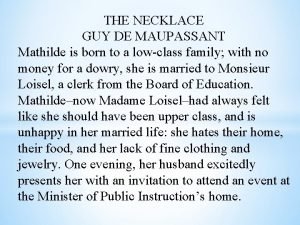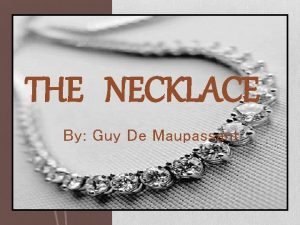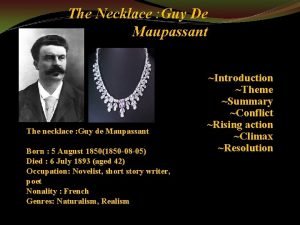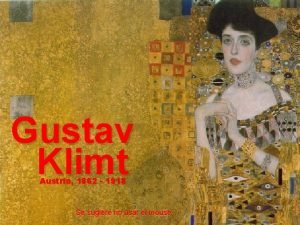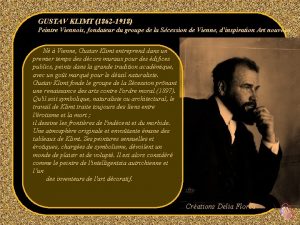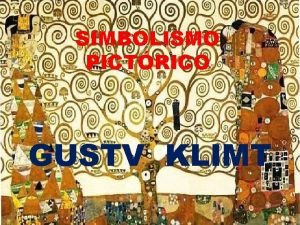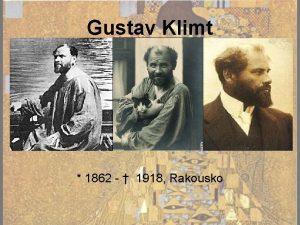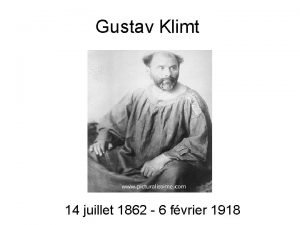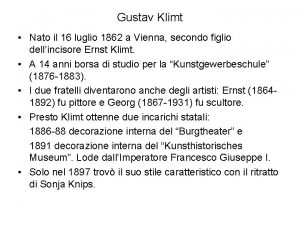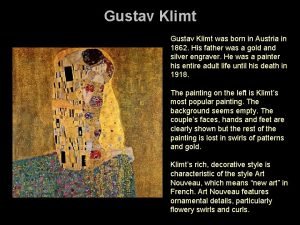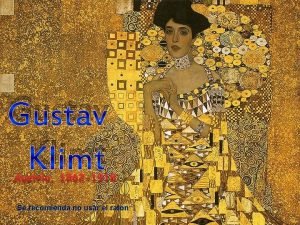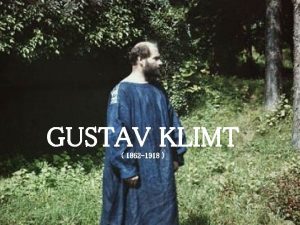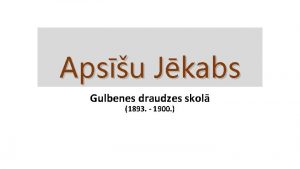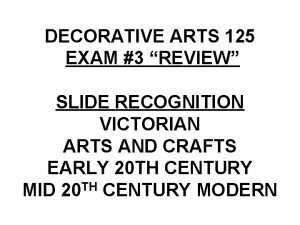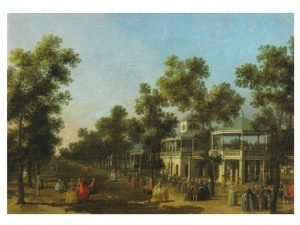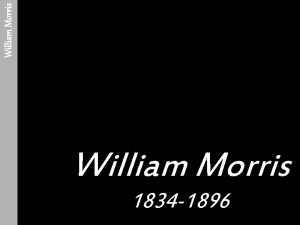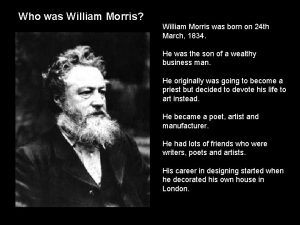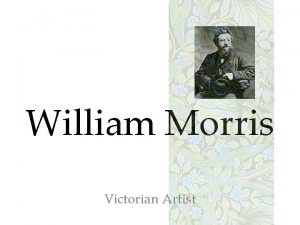Decorative Needlework 1893 May Morris 1862 1938 Arts


































- Slides: 34




Decorative Needlework (1893) May Morris (1862 - 1938)

Arts and Crafts Tudor Home in the Buena Park Historic District, Uptown, Chicago

Example of Arts and Crafts style influence on Federation architecture Observe the faceted bay window and the stone base.

Elegant swirls of vines, flowers, and leaves in perfect symmetry, William Morris’ iconic patterns are instantly recognizable. Designed during the 1800 s, Morris’ woodblock-printed wallpaper designs were revolutionary for their time, and can still be found all over the world, printed for furniture upholstery, curtains, ceramics, and even fashion accessories.

The Arts and Crafts Movement Beginning in Britain around 1880, the Arts and Crafts movement was born from the values of people concerned about the effects of industrialization on design and traditional craft. In response, architects, designers, craftsmen, and artists turned to new ways of living and working, pioneering new approaches to create decorative arts. One of the most influential figures during this time was William Morris, who actively promoted the joy of craftsmanship and the beauty of the nature. Having produced over 50 wallpaper designs throughout his career, Morris became an internationally renowned designer and manufacturer. Other creatives such as architects, painters, sculptors and designers began to take up his ideas. They began a unified art and craft approach to design, which soon spread across Europe and America, and eventually Japan, emerging as its own folk crafts movement called Mingei. William Morris Born in Walthamstow, East London in March 1834, William Morris was a poet, artist, philosopher, typographer, political theorist, and arguably the most celebrated designer of the Arts & Crafts movement. He strived to protect and revive the traditional techniques of handmade production that were being replaced by machines during the Victorian era’s Industrial Revolution. Although he dabbled in embroidery, carpet-making, poetry and literature, he mastered the art of woodblock printing, and created some of the most recognizable textile patterns of the 19 th century. Born into a wealthy middle-class family, Morris enjoyed a privileged childhood, as well as a sizable inheritance, meaning he would never struggle to earn his own income. He spent his childhood drawing, reading, and exploring forests and grand buildings, which triggered his fascination with natural landscapes and architecture. Having developed his own particular taste from a young age, he began to realize the only way he could have the beautiful home he wanted was if he designed every part of it himself. As he famously once said, “Have nothing in your houses that you do not know to be useful or believe to be beautiful. ”

http: //www. artyfactory. com/graphic_designers/william_morris. html

Inspired by 'Strawberry Thief', one of Morris' most popular textile designs

Morris' Acanthus wallpaper design, (1875, left) and a page from Morris' illuminated manuscript of the Rubaiyat of Omar Khayyam, illustrated by Edward Burne-Jones

Beauty and the Beast (c. 1863 -64) This tile panel depicts the children's fairytale 'Beauty and the Beast'. It was originally installed above a fire place in a bedroom of the artist Myles Birket Foster, at his home The Hill, Witley, Surrey. The scroll on the surrounding Swan tiles is inscribed with a description of the story, 'How a Prince who by enchantment was under the form of a beast became a man again by the love of a certain maiden'. The panel was designed by Edward Burne-Jones. The bear was based on sketches specially drawn for him by Philip Webb, who probably observed the animals at Regents Park Zoological Gardens. Lucy Faulkner, the sister of Charles Faulkner, one of the partners of Morris, Marshall, Faulkner and Co. painted Burne-Jones designs by hand onto the tiles.

Cinderella tile (c. 1863 -64) Edward Coley Burne-Jones This series of 10 tiles depicts the story of Cinderella. It was designed by Edward Burne-Jones and painted by Lucy Faulkner. Burne-Jones account book for September 30, 1862 refers to : "10 designs for tiles, Cinderella paid £ 7. 10 s" which may well be the set made for Myles Birket Foster's house, The Hill at Witley Surrey. The tiles were intended for an overmantel panel and four two tile figures, the original designs are in the V&A and Fitzwilliam. .

Cinderella tile (c. 1863 -64) Edward Coley Burne-Jones This series of 10 tiles depicts the story of Cinderella. It was designed by Edward Burne-Jones and painted by Lucy Faulkner. Burne-Jones account book for September 30, 1862 refers to : "10 designs for tiles, Cinderella paid £ 7. 10 s" which may well be the set made for Myles Birket Foster's house, The Hill at Witley Surrey. The tiles were intended for an overmantel panel and four two tile figures, the original designs are in the V&A and Fitzwilliam. .

Morris & Co. textiles The Vision of the Holy Grail tapestry, 1890

The Flora tapestry was designed by William Morris (1834 - 1896) and Edward Burne-Jones (1833 - 1898) in 1885. It depicts Flora, the goddess of abundance, who personifies summer, standing barefoot in flowing garments with a wreath in her hair. She holds fresh flowers in her hand we can see the intricate floral background, inspired by the Medieval decorative technique known as Mille Fleurs (thousand flowers), demonstrating the artists' admiration for pre. Renaissance art. The tapestry is inscribed with the following verse taken from Poems by the Way by William Morris, beautifully rendered in Gothic type: I am the handmaid of the Earth I broider fair her glorious gown and deck her on her days of mirth with many a garland of renown and while earth's little onesare fain and play about the mother's hem I scatter every gift I gain from sun and wind to gladden them

The creative approach that William Morris employed in his designs was revealed in a lecture from 1874: 'first, diligent study of Nature and secondly, study of the work of the ages of Art'. Morris felt that the 'diligent study of Nature' was important, as nature was the perfect example of God's design. He saw this as the spiritual antidote to the decline in social, moral and artistic standards during the Industrial Revolution. Likewise, the 'study of the work of the ages of Art', a reference to the appreciation of art history, was equally important as Morris encouraged artists to look to the past for their inspiration believing that the art of his own age was inferior. Morris' solution was for a return to the values of the Gothic art of the middle Ages, where artists and craftsmen had worked together with a common purpose: to glorify God through the practice of their skills. The model for this solution was the medieval crafts guilds which he saw as a type of socialist brotherhood where everybody fulfilled themselves according to their level of ability. Morris felt that this would enhance the quality of life for all, and that artistic activity itself would be seen as a force for good in society. Design for Windrush printed textile, 1881– 1883

Acanthus embroidered panel, designed Morris, 1890

Strawberry Thief, furnishing fabric, designed Morris, 1883

Wallpaper – Hyacinth, pattern #480 – 1915– 1917

Wallpaper – Blackberry, pattern #388 – 1915– 1917

The Arts and Crafts movement was an international trend in the decorative and fine arts that began in Britain and flourished in Europe and America between about 1880 and 1920, emerging in Japan in the 1920 s as the Mingei movement. It stood for traditional craftsmanship using simple forms, and often used medieval, romantic, or folk styles of decoration. It advocated economic and social reform and was essentially anti-industrial. It had a strong influence on the arts in Europe until it was displaced by Modernism in the 1930 s, [4] and its influence continued among craft makers, designers, and town planners long afterwards. Design for Trellis wallpaper, 1862

Two of Morris' designs: Snakeshead printed textile (1876) and "Peacock and Dragon" woven wool furnishing fabric (1878)

A Wooden Pattern for Textile Printing from William Morris's Company

William Morris age 23, c. 1853 This is a photo of William Morris at a turning point in his life. He was in his early twenties, and had just left university. The formal pose makes him look mild and conservative, but in fact he was surprisingly rebellious; the clenched right hand hints at his determination. His family wanted him to follow a safe and respectable career in the church, but Morris refused; he wanted to become an artist. Morris tried his hand at architecture, oil painting, calligraphy, embroidery and wood-carving, as well as writing poetry. He eventually hit on his future career as a designer almost by accident. He and his university friend, the artist Edward Burne-Jones, moved into lodgings in London. Since they had no furniture Morris began designing his own. It was the beginning of a lifelong obsession with interior design.

Jane Morris in medieval costume (1861) Morris was painting murals in the Oxford University Union when he first saw Jane Burden. He and his artist friends, Edward Burne-Jones and Dante Gabriel Rossetti, asked her to model for them. Jane, the daughter of a local stable hand, wasn’t very keen. She probably suspected their motives. When she eventually agreed Morris quickly fell in love. They married, despite their different social backgrounds, and went to live at Red House in Bexleyheath, designed for Morris by his friend Philip Webb. Morris planned to decorate the house with scenes from the Trojan War; Jane is probably posing here as the beautiful Helen of Troy. Their marriage was happy at first. They had two daughters, Jenny and May, and Jane flourished, becoming a talented musician and embroideress. Later their relationship was strained by Jane’s affair with Rossetti, but they remained married until Morris’s death in 1896.

Morris’s company decorated churches as well as houses. Religious reform and flourishing economic growth produced a great upsurge in church building which the Firm was well-placed to take advantage of. They had great success with stained-glass windows. Morris particularly admired the techniques used to produce medieval stained glass, and wanted his company’s products to be equally impressive. The Firm’s reputation was based on artist-led design, traditional techniques and high-quality materials. Morris supervised the painting and assembly of all their windows himself, choosing the colours and where to place the lines of lead joining the pieces of glass with particular care. Here, the red pomegranates and fabric look even richer against the green of the leaves and the minstrel’s robe, and his bright yellow hair gleams against the dark background.

Edward Burne-Jones sketched this affectionate cartoon on a sheet of notepaper; it shows his friend Morris giving a demonstration at the first exhibition of the newly-founded Arts and Crafts Exhibition Society. The Society wanted to provide its members with a platform for promoting their hand-crafted products. They organised lectures and demonstrations at their exhibitions to help potential customers appreciate the skills involved. Morris is weaving: he is concentrating hard with his back to the audience, his chubby body crouched over the loom as he weaves the shuttle in and out. Morris was always a hands-on craftsman, and wouldn’t introduce any technique into his workshops until he had mastered it himself. He thought no-one should design a craft object without a full understanding of how it was going to be produced.

Snakeshead - designed 1876, manufactured post 1917 Morris is well known for taking inspiration from medieval European art, but perhaps less for his interest in historic textiles from the Middle East and the Indian sub-continent. This printed fabric shows that Morris also learnt from contemporary cottons imported from India, particularly in the strongly contrasting reds and blues, and the way the three-dimensional forms of flowers and leaves could be transformed into flat patterns. Morris admired the fact that Indian cottons were hand-printed with natural, rather than chemical, dyes. In Britain knowledge of how to produce dyes from plants and vegetables was fast disappearing; most textile manufacturers found chemical dyes cheaper and easier to use. But Morris felt natural colours had a richness lacking in chemical dyes, and spent ten years working with a Staffordshire silk dyer named Thomas Wardle to revive their use.

Peacock and Dragon 1878 This was one of Morris’s favourite designs. He loved the texture of the luxurious woven wool fabric (you can see this most clearly on the blue areas). Its weight makes it perfect for curtains. What you can’t see here is the size of the pattern – it is unusually large (around a metre) so it needs a big room to show it off to best effect. The formal pairing of birds and dragons was partly inspired by historic Italian silks, though the colour scheme also echoes Islamic art. Morris thought all designers should take inspiration from the past, using their own inventiveness as well to avoid pastiche. His knowledge of historic textiles was so widely respected he became an advisor to the Victoria and Albert Museum, encouraging them to buy a Persian carpet (http: //www. vam. ac. uk/page/a/ardabil-carpet/) now recognised as one of the most important textiles in the world.

Change of Address brochure (1919) This is Morris and Co’s showroom in 1917. Morris had bought out the other partners in Morris, Marshall, Faulkner and Co in the 1870 s, and one of the first things he did to expand the business was to open a shop in Oxford Street, near Liberty’s and other up-market shops in London’s West End. The company carried on after Morris’s death in 1896, moving in 1917 from Oxford Street to nearby Hanover Square. The showroom was designed to let customers see how Morris and Co’s products might look in their own homes. There are piles of swatch books, and lengths of wallpaper displayed next to fabrics which set them off to full advantage. The shop also sold goods by other designers which complemented the house style.

Socialist banner (c. 1890 s) Morris was 49 when he crossed ‘the river of fire’ and became a revolutionary socialist. He’d always felt uneasy about the disparity between his comfortable lifestyle and the conditions endured by most of the British working class. Now he worked to overthrow the system that enabled the rich to profit from their labour, going on marches, founding newspapers and lecturing all over the country. Burne-Jones designed the image of Adam and Eve for Morris’s book A Dream of John Ball, about a priest who was one of the leaders of the Peasants’ Revolt in 1381. Ball believed all people were created equal, asking ‘When Adam delved and Eve span, who was then the gentleman? ’ Morris’s political activities shocked many of his friends, but he didn’t see campaigning as incompatible with his design work. He deeply regretted that his products were so expensive, and wanted to create a society where everyone lived comfortably in beautiful surroundings.

News From Nowhere: Or, An Epoch of Rest, Being Some Chapters from a Utopian Romance (1893) This book describes Morris’s vision of a better society. It first appeared in his socialist newspaper Commonweal, encouraging readers to continue the revolutionary struggle. Its hero William Guest (based on Morris himself) is a time-traveller who visits London in the future: free of pollution, with neither money nor private property, where people live communally and make decisions collectively, with no central government. Everyone delights in the pleasures of making beautiful things by hand. Morris’s story was later published as a book which circulated widely in a cheaply-printed edition. This copy comes from the more expensive edition produced by Morris’s Kelmscott Press. The illustration shows his country house, Kelmscott Manor in Gloucestershire. Morris wanted everyone to enjoy the peaceful happiness such beautiful surroundings could bring. News from Nowhere is now seen as the first ‘ecotopia’, a tribute to the continuing relevance of Morris’s utopian vision of sustainable living. .

https: //en. wikipedia. org/wiki/William_Morris ויליאם_מוריס https: //he. wikipedia. org/wiki/ https: //www. wmgallery. org. uk/collection/themes/william-morris/ https: //www. wmgallery. org. uk/collection/browse-the-collection/object-type/books-and-archive https: //www. haaretz. co. il/1. 2614033 https: //www. haaretz. co. il/gallery/architecture/environment/. premium-1. 2581243 https: //www. haaretz. co. il/gallery/1. 1108047 https: //www. wmgallery. org. uk/visit/gallery-displays https: //www. handerella. com/a-note-by-william-morris-on-his-aims-in-founding-the. html https: //en. wikipedia. org/wiki/Edward_Burne-Jones קלריטה ואפרים : הנכם מוזמנים להיכנס לאתר שלנו www. clarita-efraim. com. נשמח לתגובות
 May morris decorative needlework
May morris decorative needlework Morris 1938 pragmatics
Morris 1938 pragmatics Creative arts grade 8 lesson plans term 1
Creative arts grade 8 lesson plans term 1 Carlill v carbolic smoke ball co 1893
Carlill v carbolic smoke ball co 1893 The necklace by guy de maupassant climax
The necklace by guy de maupassant climax United indian patriotic association in hindi
United indian patriotic association in hindi Exposition of the necklace
Exposition of the necklace Federal safety appliance act
Federal safety appliance act Ruska petorka kompozitora
Ruska petorka kompozitora After 1880 european colonization was motivated by the
After 1880 european colonization was motivated by the Summary of the story the necklace
Summary of the story the necklace 1918-1862
1918-1862 Civil war 1861/1862
Civil war 1861/1862 1918-1862
1918-1862 Pacific railway act
Pacific railway act Peintre viennois
Peintre viennois The indian wars 1862-68
The indian wars 1862-68 Simbolismo pictorico
Simbolismo pictorico 1918-1862
1918-1862 1918-1862
1918-1862 Personaggio storico nato 1862
Personaggio storico nato 1862 1918-1862
1918-1862 Tongueofvalor
Tongueofvalor Civil war 1861/1862
Civil war 1861/1862 1918-1862
1918-1862 Lklimt
Lklimt 1918-1862
1918-1862 5 agosto 1938
5 agosto 1938 Kirjandusrühmitus
Kirjandusrühmitus Anomie theory examples
Anomie theory examples Romania in anul 1938
Romania in anul 1938 1982-1938
1982-1938 Fdr new deal political cartoon
Fdr new deal political cartoon Hva er landsmål og riksmål
Hva er landsmål og riksmål Kovani novac kraljevine jugoslavije 1938 vrednost
Kovani novac kraljevine jugoslavije 1938 vrednost




